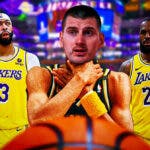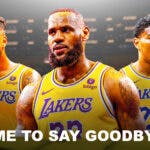The prevalence of “superteams” in the NBA is not exactly a new concept.
If you were to peek at the top, contending teams in the professional basketball league from decade to decade, you would see a common theme and the same handful of teams. This is not exactly another groundbreaking idea, but good teams often compete at a high level for a stretch of years. Dynasties like the Michael Jordan Chicago Bulls, Magic Johnson and Kareem Abdul-Jabbar Los Angeles Lakers, and Bill Russell Boston Celtics won multiple titles in a short span of time. Are they considered superteams?
The main point of differentiation between those superteams and today's can be traced back to—who else—LeBron James, however.
While the aforementioned superteams and even lesser entities like the 1990's Houston Rockets and Utah Jazz were wildly success for a solid chunk of a decade, what separates that era from what has been ushered in by James is a freedom of movement and key free-agency decisions from top players that was not the norm from more than a decade ago. We have never seen multiple players banding together for key decisions.
It's accurate to describe stars leaving their original teams for new pastures—denying that would be incredibly laughable—but it is not fair to characterize any era of the NBA aside from the 2010's as one where “stars” either existed and eclipsed stars of other professional leagues (or even the amateur level, which dominated the U.S. until the 1970's) or predicated contention like they do now.
In other words, the dawn of the “big three” or “big more” era, wrought by LeBron James' “deciding” on the Miami Heat, was not the case for much of the history of the NBA. That's not to say that superteams did not exist, as already mentioned in dynasty form, but often those teams were assembled from a top-down approach—a general manager and front office put together the pieces through trial and error versus what can be described today as natural stirrings in the NBA due to earthquake free-agency signings.
The proto–Big Three Heat were the Boston Celtics. Doc Rivers' team went from 24 wins in 2006-07 to 66 wins and a championship the next season. That can be attributed to All-Stars Kevin Garnett and Ray Allen arriving on the team; however, both joined Paul Pierce and a young point-guard savant in Rajon Rondo via trades. The trades engineered by Danny Ainge were means of a single team envisioning contention via stars. That's not that the same as stars deciding for which team they want to contend.
Take Kawhi Leonard's free agency. The two-time Finals MVP came off an improbable championship victory, with a little help from injuries bestowed upon Kevin Durant and Klay Thompson, and he took his future into his own hands. After conferring with fellow All-Star forward Paul George, Kawhi himself engineered what would be the summer's coup in the Los Angeles Clippers trading for the Oklahoma City Thunder player and signing Kawhi. One could not happen without the other. And while we have no regular season record or playoff tracker to measure if this move will pay off, clearly Leonard and George choosing to play for L.A. is a decision to form a superteam. Neither were drafted by the Clippers; they followed the LeBron model to “team up.”
James went to South Beach not for one singular season. There was Dwyane Wade. There was Chris Bosh. The three free agents made a pact to play for the Heat because they wanted to win and play with top talent. Under that definition of superteam, LeBron James is a pioneer in the concept.
The contemporary superteam also has a shorter life span, however. LeBron James and the Heat ran for four glorious seasons, reaching four consecutive Finals series, and winning two. That was success. The Golden State Warriors are coming off their fifth consecutive Finals with a core made up of players mostly drafted by the franchise—Stephen Curry, Thompson, and Draymond Green. Do the Warriors bucks the modern superteam? Yes and no. You cannot determine the mere existence of a superteam through just one title. If the Warriors extended their residency atop the Western Conference with the mentioned core plus Harrison Barnes, then that is a convincing case for the exception of the rule. However, Durant arriving in the Bay Area represents the James model of All-Stars choosing their own path towards competitiveness.
Dynasties and good teams lasting awhile, again, are not new concepts to reach the NBA. Nevertheless, players forming clubs, Banana Boats even, and carrying “all the cards” during the annual free agency frenzy is a force unseen at the current magnitude. Durant left the Warriors this summer to play with former USA Basketball gold-medalist teammates in Kyrie Irving and DeAndre Jordan. The new faces of the Brooklyn Nets could be the next dynasty, or maybe a failed coup like the Steven Nash–Dwight Howard–Kobe Bryant Lakers project.
Whether you like it or not, players' agency in the NBA will be a defining characteristic of team-building, or rather team-bending to produce dynasty aspirations. LeBron James aided in helping to make it so.




